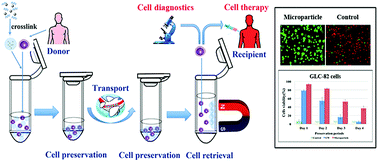The hypothermic preservation of mammalian cells with assembling extracellular-matrix-mimetic microparticles
Abstract
Hypothermic preservation at a refrigerated temperature allows feasible and flexible storage of living cells, and is of great importance for the widespread use of cell-based applications, such as cell diagnostics and cell therapy. The University of Wisconsin (UW) cold storage solution is one of the current state-of-the-art protectants for hypothermic cell preservation. However, even by using the UW solution, the current effective preservation time under refrigerated conditions is still no more than 1 or 2 days, which restraints larger geographic cell-sharing regions. Herein, we presented a facile technology based on the assembly of extracellular-matrix-mimetic microparticles, which can significantly enhance cell survival in hypothermic preservation under refrigerated conditions for at least 4 days. Moreover, compared with UW solution-based preservation, this strategy significantly inhibited cell nucleus deformation, indicating its ability to inhibit cell apoptosis. Furthermore, after being preserved, both the morphology and proliferation of the recovered cells were similar to normal cells. In addition, microparticle-based preservation could allow the free diffusion of nutrients and metabolic waste, and it was possible to easily and physically retrieve the cells using a permanent magnet. This new technology could significantly extend the preservation duration of cells and hold great promise to improve the outcome of cell therapy and diagnostic accuracy, which will benefit patients in various cell-based applications.

- This article is part of the themed collection: 2017 Journal of Materials Chemistry B HOT Papers


 Please wait while we load your content...
Please wait while we load your content...